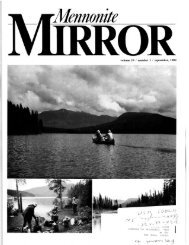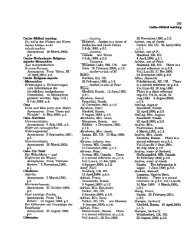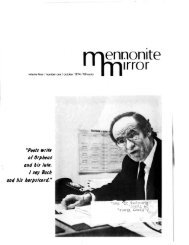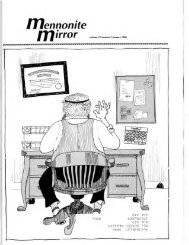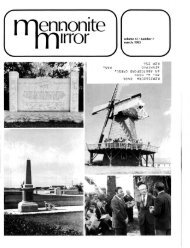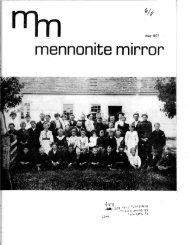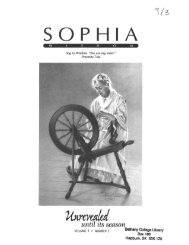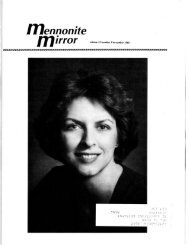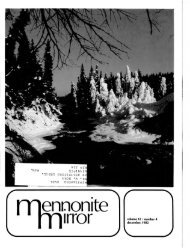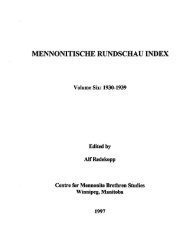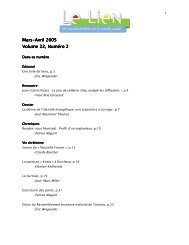ennonite - Canadian Conference of Mennonite Brethren Churches
ennonite - Canadian Conference of Mennonite Brethren Churches
ennonite - Canadian Conference of Mennonite Brethren Churches
Create successful ePaper yourself
Turn your PDF publications into a flip-book with our unique Google optimized e-Paper software.
Dr. Franz DOrksen<br />
Surgeon finds rewards in<br />
helping those crippled<br />
with leprosy<br />
by Kathleen Mazur Teillet<br />
"Dr. Durksen is one <strong>of</strong> those people<br />
you rarely meet," said Mrs. Marv<br />
Davidson <strong>of</strong> the department <strong>of</strong> orthopedics<br />
at the Health Sciences Centre.<br />
"Everyone who knows him has an<br />
extremely high regard for him and for<br />
what he is doing. He is simply exceptional."<br />
Franz Durksen, the son <strong>of</strong> Martin<br />
and Kaethe Durksen, M<strong>ennonite</strong> missionaries,<br />
was born in Chaco in northern<br />
Paraguay in 1942. When he was<br />
but a tiny boy, Franz watched his<br />
father use a woman's sewing kit to<br />
stitch up a native's badly torn chest<br />
and shoulder. The Paraguayan had<br />
been thoroughly mauled by a jungle<br />
cat and, although Martin Durksen had<br />
no medical training, the crude repair<br />
work was a success. Franz made up<br />
his mind then to become a doctor-a<br />
resolve that never wavered.<br />
When he was six, the family moved<br />
to Argentina where he received his<br />
medical training and where he met his<br />
wife, Anni, who came to South America<br />
in 1947 from Russia. Annie is a nurse<br />
and works alongside him in his medical<br />
ministry. They have four children, the<br />
oldest three born in Argentina and the<br />
youngest in Paraguay. '<br />
Franz Durksen does lay claim to a<br />
medical heritage. He is the grandson<br />
<strong>of</strong> Anne Duerksen who died in 1975 at<br />
the age <strong>of</strong> 93. Anna was a midwife and<br />
bonesetter, the only one in the colonies<br />
to <strong>of</strong>fer medical assistance <strong>of</strong> any kind.<br />
Dr. Durksen said that many Manitobans,<br />
doubtlessly, were delivered by<br />
Anna Duerksen. For the 50th anniversary<br />
<strong>of</strong> the Colony Fernheim, he is<br />
writing a book about his grandmother,<br />
and would welcome hearing from anyone<br />
who knew her.<br />
Franz and Annie Durksen came to<br />
Winnipeg three years ago in June so<br />
that Franz could do his residency in<br />
orthopedics at the Health Sciences<br />
Centre. When they return to Paraguay<br />
at the end <strong>of</strong> November Franz will join<br />
a medical team working with the<br />
victims <strong>of</strong> leprosy. He will be helping<br />
to train other doctors and physiotherapists<br />
in a rehabilitation program<br />
for these people and will be managing<br />
an Indian mission with 12 clinics. He<br />
has wide experience in leprosy having<br />
spent most <strong>of</strong> his medical career in<br />
this field.<br />
Dr. Durksen said that although<br />
there are 15 million leprosy patients in<br />
the world most <strong>Canadian</strong> doctors do<br />
not recognize the disease when they<br />
encounter it because Canada is one <strong>of</strong><br />
the few countries in the world where<br />
Hansen's Disease (leprosy) is not endemic.<br />
However, there have been<br />
about five cases in Manitoba. He said<br />
that leprosy has a long incubation time<br />
and these patients contacted the disease<br />
in other parts <strong>of</strong> the world but<br />
showed no symptoms at the time <strong>of</strong><br />
immigration. He also said that with a<br />
more mobile world population it is<br />
likely that leprosy will be seen in the<br />
future where it has been unknown<br />
before. There are presently 3,000<br />
leprosy patients in the USA and<br />
between 30 and 40 in Canada.<br />
Leprosy, while it is an infectious<br />
disease, is not as contagious as legend<br />
tells us. Most people who are in<br />
regular contact with leprosy patients<br />
show resistance to the disease after<br />
only a few months. Besides, patients<br />
become non-infectious soon after treatments<br />
begin. Dr. Durksen said about<br />
85 percent <strong>of</strong> any population, any race,<br />
anywhere, is probably completely immune<br />
to Hansen's Disease.<br />
Nevertheless, most people, including<br />
medical workers, are afraid <strong>of</strong> leprosy<br />
and refuse to care for its victims.<br />
Other people shun these patients because<br />
they believe leprosy is a result<br />
<strong>of</strong> sin. This is not true and Dr.<br />
Durksen points out that Jesus touched<br />
them (Matt. 8:1-4; Luk 17:11-19);<br />
Matthew tells us that Christ ate in a<br />
victim's home (Matt. 26:6). Leprosy is<br />
not spread by touch (Doctors are not<br />
sure <strong>of</strong> how it is actually spread but<br />
the fact is that where living standards<br />
are high it is not a problem).<br />
In spite <strong>of</strong> these superstitions, Christians<br />
have ministered to the victims <strong>of</strong><br />
Hansen's Disease since Biblical times<br />
and, even now, many patients are<br />
dependent on the Church for their<br />
entire care. The Hospital Menonita,<br />
Km 81, in the heart <strong>of</strong> Paraguay, was<br />
begun in 1951 for just such a Christian<br />
service to people with leprosy.<br />
Franz Durksen follows in this commendable<br />
tradition.<br />
It was in 1971 that Dr. Durksen<br />
began operating on feet and hands<br />
which had lost their natural function<br />
because <strong>of</strong> leprosy. This is complicated<br />
reconstructive surgery wherein 'dead'<br />
muscles are replaced by healthy ones.<br />
He is the only doctor in South America<br />
to do this type <strong>of</strong> surgery but upon his<br />
return he will train other doctors to do<br />
the same kind <strong>of</strong> work.<br />
Dr. Durksen said that such surgical<br />
rehabilitation can <strong>of</strong>fer much to the<br />
leprosy patient but it is only one part<br />
<strong>of</strong> the battle. "The social rehabilitation<br />
remains the most difficult part to<br />
overcome and this requires a new<br />
attitude in society toward the diseased<br />
patient and the disease itself." He<br />
tries constantly to educate society<br />
toward an acceptance <strong>of</strong> these victims.<br />
He said, "There should be no more<br />
lepers in the world-



